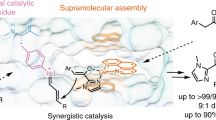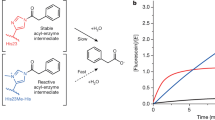Abstract
Creating designer enzymes with the ability to catalyse abiological transformations is a formidable challenge. Efforts toward this goal typically consider only canonical amino acids in the initial design process. However, incorporating unnatural amino acids that feature uniquely reactive side chains could significantly expand the catalytic repertoire of designer enzymes. To explore the potential of such artificial building blocks for enzyme design, here we selected p-aminophenylalanine as a potentially novel catalytic residue. We demonstrate that the catalytic activity of the aniline side chain for hydrazone and oxime formation reactions is increased by embedding p-aminophenylalanine into the hydrophobic pore of the multidrug transcriptional regulator from Lactococcus lactis. Both the recruitment of reactants by the promiscuous binding pocket and a judiciously placed aniline that functions as a catalytic residue contribute to the success of the identified artificial enzyme. We anticipate that our design strategy will prove rewarding to significantly expand the catalytic repertoire of designer enzymes in the future.
This is a preview of subscription content, access via your institution
Access options
Access Nature and 54 other Nature Portfolio journals
Get Nature+, our best-value online-access subscription
$29.99 / 30 days
cancel any time
Subscribe to this journal
Receive 12 print issues and online access
$259.00 per year
only $21.58 per issue
Buy this article
- Purchase on Springer Link
- Instant access to full article PDF
Prices may be subject to local taxes which are calculated during checkout




Similar content being viewed by others
References
Hilvert, D. Design of protein catalysts. Annu. Rev. Biochem. 82, 447–470 (2013).
Nanda, V. & Koder, R. L. Designing artificial enzymes by intuition and computation. Nat. Chem. 2, 15–24 (2010).
Huang, P.-S., Boyken, S. E. & Baker, D. The coming of age of de novo protein design. Nature 537, 320–327 (2016).
Woolfson, D. N. et al. De novo protein design: how do we expand into the universe of possible protein structures? Curr. Opin. Struct. Biol. 33, 16–26 (2015).
Hilvert, D. Critical analysis of antibody catalysis. Annu. Rev. Biochem. 69, 751–793 (2000).
Kiss, G., Çelebi-Ölçüm, N., Moretti, R., Baker, D. & Houk, K. N. Computational enzyme design. Angew. Chem. Int. Ed. 52, 5700–5725 (2013).
Renata, H., Wang, Z. J. & Arnold, F. H. Expanding the enzyme universe: accessing non-natural reactions by mechanism-guided directed evolution. Angew. Chem. Int. Ed. 54, 3351–3367 (2015).
Schwizer, F. et al. Artificial metalloenzymes: reaction scope and optimization strategies. Chem. Rev. 118, 142–231 (2018).
Okeley, N. M. & van der Donk, W. A. Novel cofactors via post-translational modifications of enzyme active sites. Chem. Biol. 7, 159–171 (2000).
van Poelje, P. D. & Snell, E. E. Pyruvoyl-dependent enzymes. Annu. Rev. Biochem. 59, 29–59 (1990).
Appel, M. J. & Bertozzi, C. R. Formylglycine, a post-translationally generated residue with unique catalytic capabilities and biotechnology applications. ACS Chem. Biol. 10, 72–84 (2015).
Cooke, H. A., Christianson, C. V. & Bruner, S. D. Structure and chemistry of 4-methylideneimidazole-5-one containing enzymes. Curr. Opin. Chem. Biol. 13, 460–468 (2009).
Agostini, F. et al. Xenobiology meets enzymology: exploring the potential of unnatural building blocks in biocatalysis. Angew. Chem. Int. Ed. 56, 9680–9703 (2017).
Liu, C. C. & Schultz, P. G. Adding new chemistries to the genetic code. Annu. Rev. Biochem. 79, 413–444 (2010).
Dumas, A. et al. Designing logical codon reassignment – expanding the chemistry in biology. Chem. Sci. 6, 50–69 (2015).
Neumann-Staubitz, P. & Neumann, H. The use of unnatural amino acids to study and engineer protein function. Curr. Opin. Struct. Biol. 38, 119–128 (2016).
Green, A. P., Hayashi, T., Mittl, P. R. E. & Hilvert, D. A chemically programmed proximal ligand enhances the catalytic properties of a heme enzyme. J. Am. Chem. Soc. 138, 11344–11352 (2016).
Drienovská, I., Rioz-Martinez, A., Draksharapu, A. & Roelfes, G. Novel artificial metalloenzymes by in vivo incorporation of metal-binding unnatural amino acids. Chem. Sci. 6, 770–776 (2015).
Bersellini, M. & Roelfes, G. Multidrug resistance regulators (MDRs) as scaffolds for the design of artificial metalloenzymes. Org. Biomol. Chem. 15, 3069–3073 (2017).
Hu, C., Chan, S. I., Sawyer, E. B., Yu, Y. & Wang, J. Metalloprotein design using genetic code expansion. Chem. Soc. Rev. 43, 6498 (2014).
Mehl, R. A. et al. Generation of a bacterium with a 21 amino acid genetic code. J. Am. Chem. Soc. 125, 935–939 (2003).
Carrico, Z. M. et al. Oxidative coupling of peptides to a virus capsid containing unnatural amino acids. Chem. Commun. 369, 1205–1207 (2008).
Cordes, E. H. & Jencks, W. P. Nucleophilic catalysis of semicarbazone formation by anilines. J. Am. Chem. Soc. 84, 826–831 (1962).
Dirksen, A., Dirksen, S., Hackeng, T. M. & Dawson, P. E. Nucleophilic catalysis of hydrazone formation and transimination: implications for dynamic covalent chemistry. J. Am. Chem. Soc. 128, 15602–15603 (2006).
Dirksen, A., Hackeng, T. M. & Dawson, P. E. Nucleophilic catalysis of oxime ligation. Angew. Chem. Int. Ed. 45, 7581–7584 (2006).
Crisalli, P. & Kool, E. T. Water-soluble organocatalysts for hydrazone and oxime formation. J. Org. Chem. 78, 1184–1189 (2013).
Crisalli, P. & Kool, E. T. Importance of ortho proton donors in catalysis of hydrazone formation. Org. Lett. 15, 1646–1649 (2013).
Wendeler, M., Grinberg, L., Wang, X., Dawson, P. E. & Baca, M. Enhanced catalysis of oxime-based bioconjugations by substituted anilines. Bioconjug. Chem. 25, 93–101 (2014).
Agustiandari, H., Lubelski, J., van den Berg van Saparoea, H. B., Kuipers, O. P. & Driessen, A. J. M. LmrR is a transcriptional repressor of expression of the multidrug ABC transporter LmrCD in Lactococcus lactis. J. Bacteriol. 190, 759–763 (2008).
Madoori, P. K., Agustiandari, H., Driessen, A. J. M. & Thunnissen, A.-M. W. H. Structure of the transcriptional regulator LmrR and its mechanism of multidrug recognition. EMBO J. 28, 156–166 (2009).
Bos, J., Fusetti, F., Driessen, A. J. M. & Roelfes, G. Enantioselective artificial metalloenzymes by creation of a novel active site at the protein dimer interface. Angew. Chem. Int. Ed. 51, 7472–7475 (2012).
Bos, J., Browne, W. R., Driessen, A. J. M. & Roelfes, G. Supramolecular assembly of artificial metalloenzymes based on the dimeric protein LmrR as promiscuous scaffold. J. Am. Chem. Soc. 137, 9796–9799 (2015).
Chin, J. W. et al. Addition of p-azido-l-phenylalanine to the genetic code of Escherichia coli. J. Am. Chem. Soc. 124, 9026–9027 (2002).
Fibriansah, G. et al. Crystal structures of two transcriptional regulators from Bacillus cereus define the conserved structural features of a PadR subfamily. PLoS One 7, e48015 (2012).
Albanese, D. C. M. & Gaggero, N. Albumin as a promiscuous biocatalyst in organic synthesis. RSC Adv. 5, 10588–10598 (2015).
Braisted, A. C. & Schultz, P. G. An antibody-catalyzed bimolecular Diels–Alder reaction. J. Am. Chem. Soc. 112, 7430–7431 (1990).
Gouverneur, V. E. et al. Control of the exo and endo pathways of the Diels–Alder reaction by antibody catalysis. Science 262, 204–208 (1993).
Yli-Kauhaluoma, J. T. et al. Anti-metallocene antibodies: a new approach to enantioselective catalysis of the Diels–Alder reaction. J. Am. Chem. Soc. 117, 7041–7047 (1995).
Xu, J. et al. Evolution of shape complementarity and catalytic efficiency from a primordial antibody template. Science 286, 2345–2348 (1999).
Siegel, J. B. et al. Computational design of an enzyme catalyst for a stereoselective bimolecular Diels–Alder reaction. Science 329, 309–313 (2010).
Key, J. A., Li, C. & Cairo, C. W. Detection of cellular sialic acid content using nitrobenzoxadiazole carbonyl-reactive chromophores. Bioconjug. Chem. 23, 363–371 (2012).
Acknowledgements
This project was supported by the European Research Council (ERC starting grant no. 280010) and the Netherlands Organisation for Scientific Research (NWO) (Vici grant 724.013.003, and Veni grant 722.017.007). G.R. acknowledges support from the Ministry of Education Culture and Science (Gravitation programme no. 024.001.035). C.M. acknowledges a Marie Skłodowska Curie Individual Fellowship (project no. 751509). The authors thank A. Borg for preparing the plasmid harbouring the bcPadR1 gene and M. de Vries for performing trypsin digestion and LC–MS/MS analyses.
Author information
Authors and Affiliations
Contributions
I.D. and C.M. contributed equally to this work. G.R. and I.D. conceived the project. I.D., C.M. and G.R. planned the experiments and wrote the manuscript. I.D., C.M. and C.D. performed the experimental work. All authors discussed the results and commented on the manuscript.
Corresponding author
Ethics declarations
Competing interests
The authors declare no competing interests.
Additional information
Publisher’s note: Springer Nature remains neutral with regard to jurisdictional claims in published maps and institutional affiliations.
Supplementary information
Supplementary Information
Supplementary Tables 1–3, Supplementary Figures 1–8, a list of materials and equipment used, procedures for the chemical syntheses of substrates and products, an extended Methods section, a list of primers used, NMR spectra of synthesized compounds, and Supplementary References
Rights and permissions
About this article
Cite this article
Drienovská, I., Mayer, C., Dulson, C. et al. A designer enzyme for hydrazone and oxime formation featuring an unnatural catalytic aniline residue. Nature Chem 10, 946–952 (2018). https://doi.org/10.1038/s41557-018-0082-z
Received:
Accepted:
Published:
Issue Date:
DOI: https://doi.org/10.1038/s41557-018-0082-z



